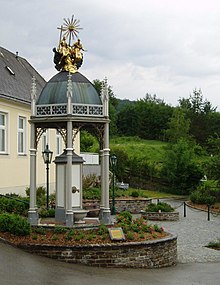St. Corona am Schöpfl
|
St. Corona am Schöpfl ( village ) locality cadastral community St. Corona |
||
|---|---|---|
|
|
||
| Basic data | ||
| Pole. District , state | Baden (BN), Lower Austria | |
| Judicial district | to bathe | |
| Pole. local community | Altenmarkt an der Triesting | |
| Coordinates | 48 ° 4 '0 " N , 15 ° 55' 0" E | |
| height | 580 m above sea level A. | |
| Residents of the village | 339 (January 1, 2020) | |
| Building status | 143 (2001) | |
| Area d. KG | 14.28 km² | |
| Statistical identification | ||
| Locality code | 03417 | |
| Cadastral parish number | 04306 | |
| Counting district / district | St. Corona am Schöpfl (30602 004) | |
| Source: STAT : index of places ; BEV : GEONAM ; NÖGIS | ||
St. Corona am Schöpfl is a village in the municipality of Altenmarkt an der Triesting , it is located between Altenmarkt- Kleinmariazell and Klausen-Leopoldsdorf am Berg Schöpfl in the Vienna Woods . The place forms the cadastral community St. Corona . The place is at an altitude of 580 meters and has 339 inhabitants (January 1, 2020).
history
- Neolithic, Bronze Age - Part of a Neolithic ax was found in St. Corona am Miesenberg , a subordinate rag ax from the Bronze Age (early Urnfield Age, 1000–800 BC ) in the moat in Thenneberg , and a Bronze Age spearhead on the Vestenberg .
- 1000 or 1200 pilgrims moved to this remote, uninhabited area - called Heiligenbrunn - to experience relief and healing through the miraculous powers of the holy well there . Old crutches and votive offerings can still be seen in the church today.
- 1444 - The pilgrimages increased, a wooden chapel was built on the location of the source - the Bishop of Passau, dedicated to St. Corona - St.Corona was born.
- 1529 - The Turks burned the chapel down.
- 1683 - The legend tells that a monk from the nearby Mariazell Monastery threw a monstrance into the well to save it from the Turks, whereupon the horses of the pursuers froze and went to their knees. The host was still intact after 60 years. An old wood carving in the church shows this scene.
- 1694 - The Bannwald , which was still uninhabited and in imperial ownership, is settled with families of woodcarvers from the Alpine countries of the Habsburg Monarchy.
- 1722 - The current parish and pilgrimage church is completed and also consecrated to Saint Corona . The mother parish is the Benedictine monastery Mariazell in Austria (Kleinmariazell) and from 1782 - in the course of the Josephine reforms - the Melk monastery .
- 1877 - The holy well gets its present appearance.
- 1945 - The place and the mountain Schöpfl are fiercely contested in the final phase of the Second World War . See also history of Alland .
- 1969 - The Leopold Figl Observatory is opened as a branch of the Vienna University Observatory on the Mitterschöpfl near St. Corona.
- 1972 - The village of St. Corona becomes the cadastral municipality of Altenmarkt.
- 1996 - The magnificent fountain setting is renovated.
See also History of the Vienna Woods .
school
A school was built around 1900, which in 1916 taught 110 students in the area. In 1927 the building was increased and in 1971, in the course of the amalgamation of the municipalities, operations were discontinued. Today the children go to Altenmarkt, Weissenbach or Klausen-Leopoldsdorf for class. The old school is now used as a rehearsal room for musicians and as a carpentry workshop.
Web links
Remarks
- ↑ The sacred building of the plant was on September 9, 1877 consecrated . - See: Daily News. (...) From the holy well. In: Das Vaterland , September 3, 1877, p. 1, bottom right. (Online at ANNO ).








